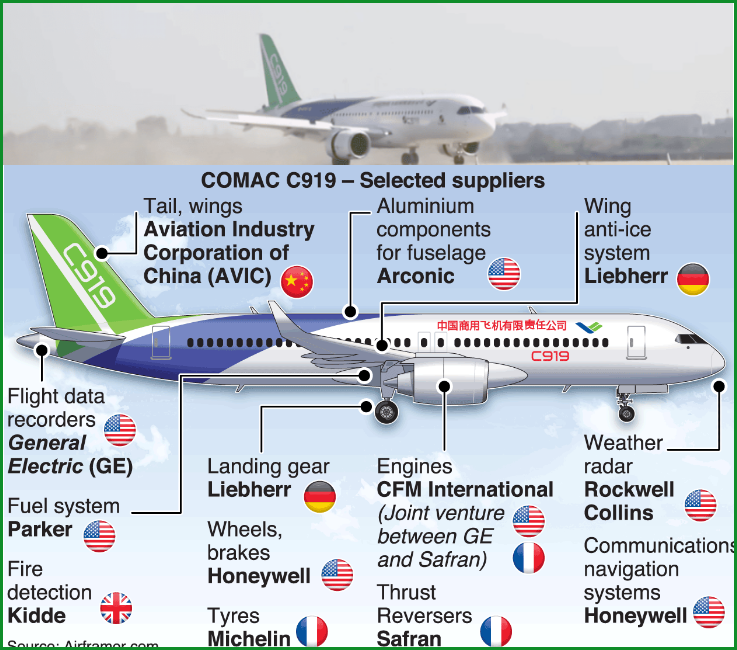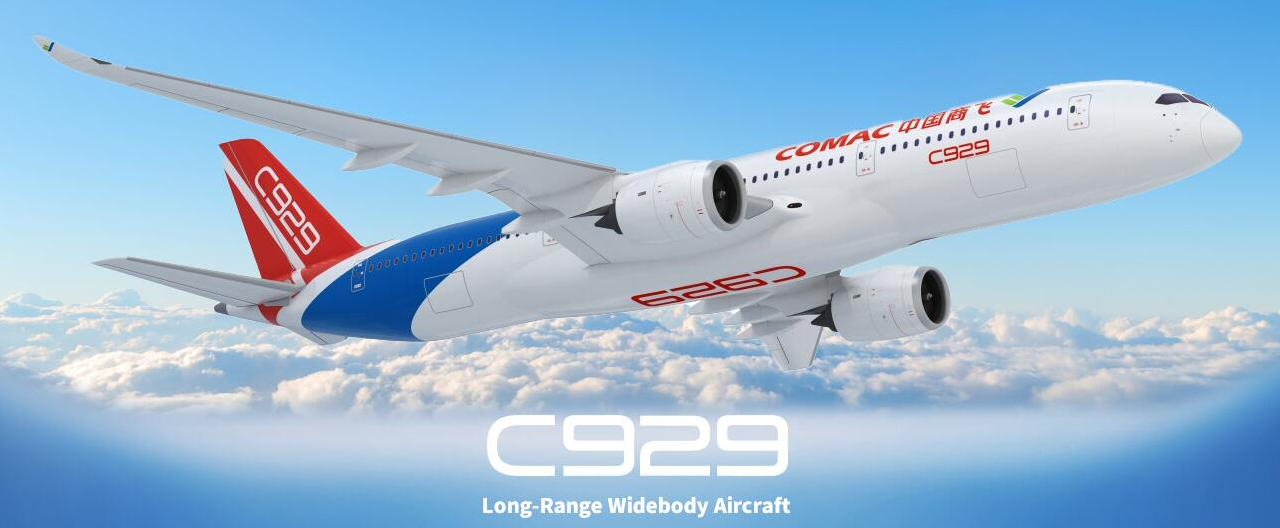Leeham News and Analysis
There's more to real news than a news release.
Airbus sees Boeing as medium-term competitor, with Comac next
By Scott Hamilton
 June 14, 2025, © Leeham News: Airbus and Boeing forecast a significant production gap during the next 20 years of more than 2,000 aircraft per year in their current outlooks released in conjunction with the Paris Air Show. The event begins Monday.
June 14, 2025, © Leeham News: Airbus and Boeing forecast a significant production gap during the next 20 years of more than 2,000 aircraft per year in their current outlooks released in conjunction with the Paris Air Show. The event begins Monday.
Neither company can fill this gap given their current production rates and the goals they have for the rest of this decade.
This means other manufacturers must step up. The question is who?
China’s Comac is current producing a competitor to the Airbus A320neo and Boeing 737 MAX, the C919. But the production rate is excruciatingly low.
Comac also has plans for a widebody airplane to compete with the Airbus A330-900 and Boeing 787. If past is prologue, development of this aircraft will be much longer than the target entry into service of 2029.
Embraer currently is the world’s third largest airliner manufacturer. However, its jets seat between 76- and 144 seat. The company is studying whether to enter the mainline jet sector, but the decision seems a year or more away.
Start-up JetZero wants to develop a Blended Wing Body aircraft for the 250-300 seat sector. But it has little money, no engine and, LNA believes, little hope of meeting the ambitious timeline of having a demonstrator aircraft by 2027.
In a media briefing on June 13, Airbus named Boeing as its medium-term competitor; China is most like to become one; Embraer is a question mark; and JetZero appears to be making little progress, in its view.
How good is the C929? Part 2.
Subscription required
By Bjorn Fehrm
April 24, 2025, © Leeham News: We started looking at the future COMAC C929 widebody 10 days ago. The C929 development has gone through a number of challenges, the first being how to structure the cooperation between China’s COMAC and Russia’s United Aircraft, with the latest being what engines to use for the aircraft.
The first problem was solved by COMAC deciding to go it alone, whereas the last problem around engines has no definite solution yet.
Summary:
- The C929 airframe is taking form with detailed design having started, according to COMAC.
- The engine side is less settled. The likely engine is the Chinese CJ-2000, a 78,000lbf development of the CJ-1000A engine aimed at the C919.
- We apply the CJ-2000’s likely performance to the C929 airframe and use our Aircraft Performance and Cost Model (APCM) to predict the C929’s operational performance.
China bans Boeing, US parts imports in tariff war
April 15, 2025, © Leeham News: It was inevitable: China has banned its airlines from accepting deliveries of Boeing airplanes.
The move is in retaliation against President Donald Trump’s boosting tariffs on Chinese goods to 145%. Beijing placed retaliatory tariffs on US goods to 125%. During the first Trump administration, the president placed tariffs of 25% on Chinese goods imported to the US. Beijing has allowed delivery of very few Boeing jets since then.

Illustration of many of the systems and components COMAC sources for its C919 jet. The smaller C909 regional jet is similarly sourced. Credit: Airframer.com.
The move once more blocks Boeing from the world’s second biggest aviation trade market. Additionally, Beijing blocked the import of US-made parts, according to Bloomberg News, which first reported the actions.
Boeing welcomes COMAC competition as Asia-Pacific demand soars
Subscription Required
By Leeham News Team
April 15, 2025, © Leeham News: Boeing sees long-term growth potential in the Asia-Pacific commercial market, but the company also acknowledges that China’s domestically produced COMAC C919 poses a credible challenge in the single-aisle segment—particularly in China and potentially in the broader region over time.
With China’s state-backed aerospace ambitions gaining momentum, the U.S. manufacturer faces a new challenge threatening to unbalance the traditional duopoly with Airbus.
According to Boeing’s 2024 Commercial Market Outlook (CMO), Southeast Asia will require more than 4,700 new aircraft over the next 20 years. About 80% of this demand will be for single-aisle aircraft—a space Boeing would ordinarily seek to dominate with its 737 MAX family.
COMAC may still have work to do to gain credibility for the C919 inside and outside China, but its short-medium-range airliner is proving popular in its domestic market (Air China, China Eastern Airlines, and China Southern Airlines are current operators). The planemaker is now seeking customers elsewhere in the region, including Indonesia, Cambodia, and Kazakhstan. How potential U.S. tariffs will alter airline customer decision-making between Boeing and its rivals remains to be seen.
Speaking to LNA as the Routes Asia forum got underway, Dave Schulte, managing director of Boeing Commercial Marketing for Northeast Asia, Southeast Asia, and Oceania, said he welcomed the contest for supremacy.
“Competition is always good for the aviation industry,” Schulte said when asked about the impact of COMAC on Boeing’s plans in the region. “It makes everyone in the industry invest in better technologies and find solutions to meet evolving customer needs.
“In the future, airlines will need to make longer-term fleet decisions that support growth and profitability, while providing competitive fares and service levels to the public.
“To achieve this goal, airlines across the region and globally evaluate airplanes based on performance capabilities, comfort level for passengers, economics, and more.” Read more
How good is the C929?
Subscription required
By Bjorn Fehrm
April 14, 2025, © Leeham News: The COMAC C919 is finding its first customers outside China. At the same time as COMAC has started work on shorter and longer versions of the C919, work on a widebody C929 has been going on for the last 14 years.
If the development of more family members for the single aisle C919 is straightforward, the widebody C929 development has presented several challenges.
Summary:
- The C929 has been in development since 2011.
- The project was first delayed by Russia-China relations and recently by increasing tensions between China and the West.
- The latest problems are around the engines, as Western engines have become politically impossible.
Read more
How good is the C919? Part 3.
Subscription required
By Bjorn Fehrm
April 3, 2025, © Leeham News: The COMAC C919 is finding its first customers outside China, which gives us a reason to examine the aircraft.
Last week, we estimated its efficiency versus its Western “look-a-like,” the Airbus A320neo. Now, we look at new variants that have been announced and how competitive these would be.

Figure 1. The C919 and its variants are analyzed by the Leeham Aircraft Performance and Cost Model, APCM. Source: Leeham Co.
Summary:
- The C919, sized like an A320neo, is the first variant in a family of aircraft.
- The next C919 variant is a shorter model for hot and high airfield operation.
- The following variant is an A321neo-sized aircraft.
How good is the COMAC C919?
Subscription required
By Bjorn Fehrm
March 20, 2025, © Leeham News: The COMAC C919 is finding its first customers outside China, with an order from the Brunei-based GallopAir upstart being first with an order for 30 C919 in September 2023. These aircraft cannot be delivered until the Brunei regulator has approved the C919 Chinese certification, which was issued by the Chinese regulator in September 2022.
Deliveries to Chinese airliners began in December 2022, with 2023 mostly spent on route proving with China Eastern Airlines first delivered aircraft. China Eastern took delivery of a further two C919s during 2023. COMAC delivered 13 C919s in 2024 to China Eastern Airlines (8), Air China (2), and China Southern Airlines (3).
The second Air China C919 was the first C919ER version, featuring a 3,000nm nominal range, whereas the others were the standard 2,200nm version.
With deliveries now at around one aircraft per month and the start of marketing to airlines outside China, it’s time to examine the C919 more closely and compare it to the Airbus A320neo and Boeing 737 MAX.
Summary:
- The C919 has now reached series delivery, with 13 aircraft delivered during 2024.
- The first sales campaigns outside China have started.
- How significant a threat will the C919 pose to Airbus and Boeing?
2025 remains another year for recovery in commercial aerospace
Subscription Required
By Scott Hamilton
Jan. 6, 2025, © Leeham News: Don’t look for any dramatic new product launches in 2025.
 Nor should you expect any dramatic news, absent global upheaval of some kind.
Nor should you expect any dramatic news, absent global upheaval of some kind.
This year is going to be yet another year dominated by recovery. Recovery from the COVID-19 pandemic, which officially ended in 2022. Recovery by the supply chain. Recovery for Pratt & Whitney’s nearly decade-long problems with its Pure Power GTF engines supplying the Airbus A220, A320 family and Embraer E2 jets. Recovery by Airbus from its production and delivery delays. Recovery by Boeing from its series of self-inflicted crises, now beginning the sixth year.
There is just no getting around the fact that the commercial aerospace industry isn’t a smooth-running industry. It’s a long way from 2018, when all sectors were running smoothly. There is still a long way to go to recovery.
Here’s LNA’s take on what’s to come this year.




